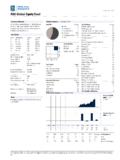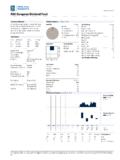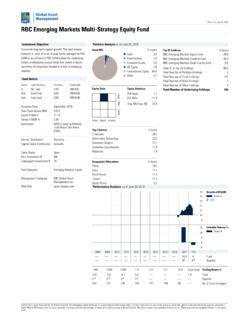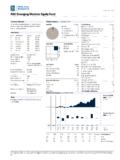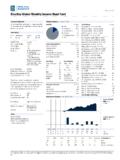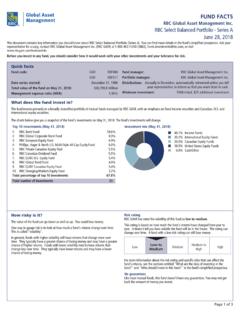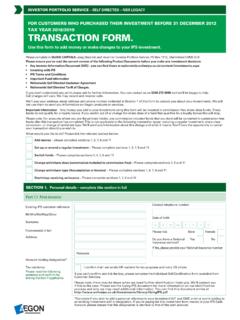Transcription of TAXES & INVESTING IN MUTUAL FUNDS
1 TAXES & INVESTING IN MUTUAL FUNDSO verview 1 Why understanding TAXES is important 1 When do I pay TAXES on my MUTUAL fund investments? 1 TAXES associated with selling or switching your MUTUAL fund 2 switching between MUTUAL FUNDS 2 What is adjusted cost base (ACB)? 3 MUTUAL fund distributions and TAXES 4 What are the different types of distributions? 5 What is the federal dividend tax credit? 8 Understanding the impact of MUTUAL fund distributions 9 Why does a fund price go down when it pays a distribution? 9 How do reinvested distributions affect ACB? 10 Considerations when purchasing a fund close to year-end 11 Corporate class FUNDS 12 What is a corporate class fund ?
2 12 Corporate class fund distributions 12 Return of capital (ROC) distributions 13 What is ROC? 13 What are the main benefits of ROC? 13 How ROC affects your ACB 14 The long-term impact of ROC distributions 15 Understanding your year-end tax slips 16 Common MUTUAL fund questions for tax season 19 ContentsTaxes & INVESTING in MUTUAL Funds1 Over viewWhy understanding TAXES is importantThis guide provides general tax information related to the purchase and sale of MUTUAL fund investments in a non-registered account, with a specific focus on how MUTUAL fund distributions are taxed. The goal is to help you gain a better understanding of tax considerations related to your MUTUAL fund investments.
3 What is a MUTUAL fund ?The majority of MUTUAL FUNDS in Canada are MUTUAL fund trusts. Investors in MUTUAL fund trusts receive units of the trust and are referred to as , MUTUAL FUNDS can also be set-up as corporations. Commonly referred to as corporate class MUTUAL FUNDS , these structures are set up with multiple share classes. Each share class, often referred to as a corporate class fund , represents a different MUTUAL fund . For more information on corporate class FUNDS , refer to page a basic level, MUTUAL FUNDS use money received from unit holders or shareholders to buy securities. The securities purchased depend on the fund s investment objective, but generally include cash, bonds and stocks.
4 These investments may generate income in the form of interest or dividends. In addition, capital gains or losses may be realized when securities held in the fund are earned within a fund is first used to pay its management and administration fees. When added together, the management fee and the administration fee (plus applicable TAXES ) make up the Management Expense Ratio (MER). The income that is left over is distributed to unitholders. When do I pay TAXES on my MUTUAL fund investments?Generally, the taxable events on your MUTUAL fund investments fall into two categories: When you sell or switch a fund When you receive income from a fund through a distributionPrinciples related to TAXES and investingStructure your overall portfolio to be tax efficientPlacing different types of investments in different types of accounts ( inside or outside of registered plans) can reduce your tax costs and increase the tax effectiveness of your overall cash flow in retirement with a tax-efficient portfolioIn retirement, the after-tax cash flow that you receive from your taxable, non-registered investments becomes increasingly important.
5 Choosing investments that benefit from favourable tax treatment can help you generate more income in retirement. Work with an advisorWorking with a knowledgeable investment professional can help you learn about how different types of investments are taxed and how you can build a tax-efficient portfolio. This guide discusses the impact of taxation on MUTUAL FUNDS in non-registered accounts. MUTUAL FUNDS held within tax-sheltered plans, such as TFSAs, RRSPs, RRIFs and RESPs, are not covered in this & INVESTING IN MUTUAL FUNDS2 TAXES associated with selling or switching your MUTUAL fundCapital gain (or capital loss) As with any investment, there are tax considerations related to the purchase and sale of MUTUAL FUNDS .
6 Here is what you need to know: If you sell a MUTUAL fund investment and the proceeds exceed your adjusted cost base, you realize a capital gain. Realized capital gains must be reported for tax purposes in the year of sale. Capital gains are also taxed more favourably than interest, dividend and foreign income. Under current tax rules, only 50% of a capital gain is taxable. If you sell a MUTUAL fund investment and the proceeds are less than your adjusted cost base, you realize a capital loss. Most capital losses can be applied against capital gains to reduce the amount of TAXES payable. If you have no realized capital gains in the year a capital loss is realized, the capital loss can be carried back and applied against taxable capital gains from any of the previous three years.
7 You are also allowed to carry the capital loss forward indefinitely to offset gains in future years In general, you can calculate your capital gain or capital loss using the following formula:Capital gain (or capital loss)=Proceeds from sale of an investment Adjusted Cost Base** See page 3 for more information about the calculation of Adjusted Cost between MUTUAL fundsIf you switch between MUTUAL fund trusts in a non-registered account, you are deemed to have sold units of one fund and purchased units in another. If the units you sold are worth more than what you originally purchased them for, the switch will generate a capital gain.
8 If the units you sold are worth less than what you originally paid, the switch will generate a capital switching between FUNDS , keep in mind that you are required to keep track of your capital gain and include its taxable portion in your taxable income in the year of sale. Speak to your financial advisor to understand the implications before switching your investments. HELPFUL TIPSIn order to assist in your annual tax reporting for these transactions, your fund company or investment dealer will issue a statement of your MUTUAL fund transactions (also known as T5008/Relev 18) at the end of the year. This report lists any investments in your account that were sold or redeemed during the calendar & INVESTING in MUTUAL Funds3 HELPFUL TIPSW hile we recommend that you refer to your own investment records to calculate the ACB you use in determining your capital gain or loss, average cost information may be provided by your investment dealer on an ongoing basis as part of your account statement.
9 This could be provided in addition to transaction history, account balances and a personal rate of return on your is adjusted cost base (ACB)?When calculating a capital gain or loss, the ACB plays an important role. It can be thought of as the average price paid for units owned. When you sell your MUTUAL fund , it is the ACB that determines whether you have realized a capital gain or a capital loss. How to calculate ACBThe following example shows how ACB is calculated and whether a capital gain or a capital loss results: Jason s investmentsJason purchases 100 units of a fund for $10 per unit$1,000At some point later, Jason buys 50 more units of the same fund at $12 per unit$600 Jason has a total of 150 units and a total investment of $1,600$1,600 Jason s ACB can be calculated as follows.
10 ACB per unit = $1,600 total investment = $ 150 units of the fund How to calculate the taxable capital gain (or capital loss)Continuing with the Jason scenario, the following example shows whether a capital gain or a capital loss results when Jason sells his units: Assume Jason later sells the holdings at a unit price of $ Because the ACB of each of Jason s units is $ , it results in a capital gain of $ per unit: $ $ = $ The total capital gain is $ : $ per unit capital gain x 150 units owned = $ Under the current rules, only 50% of the capital gain ( $ ) would be subject to tax: $ x 50% = $ Assuming a marginal tax rate of 26%, it would result in TAXES payable of $ : $ x 26% = $ & INVESTING IN MUTUAL FUNDS4 Why do MUTUAL FUNDS make distributions?



